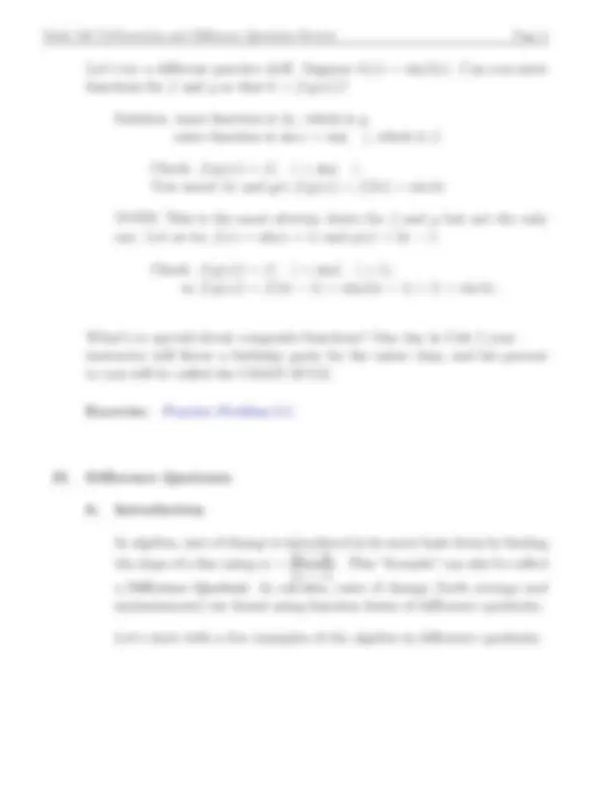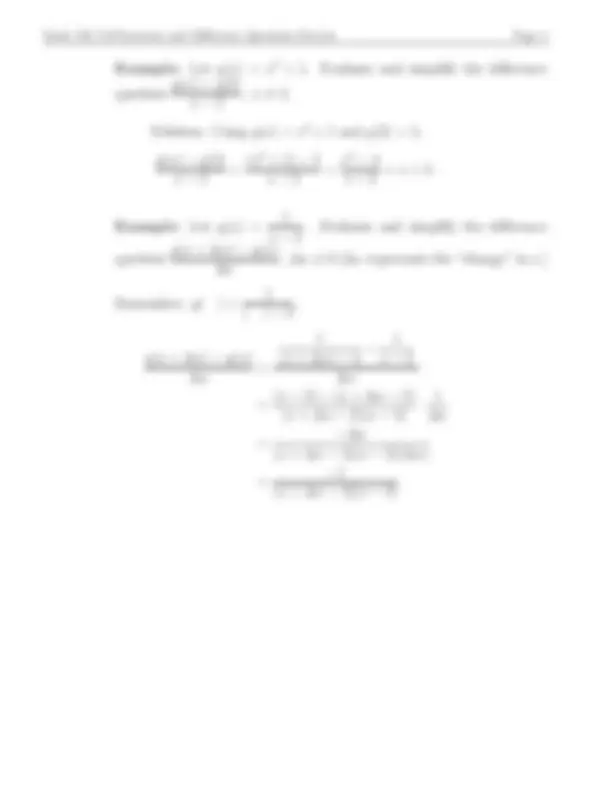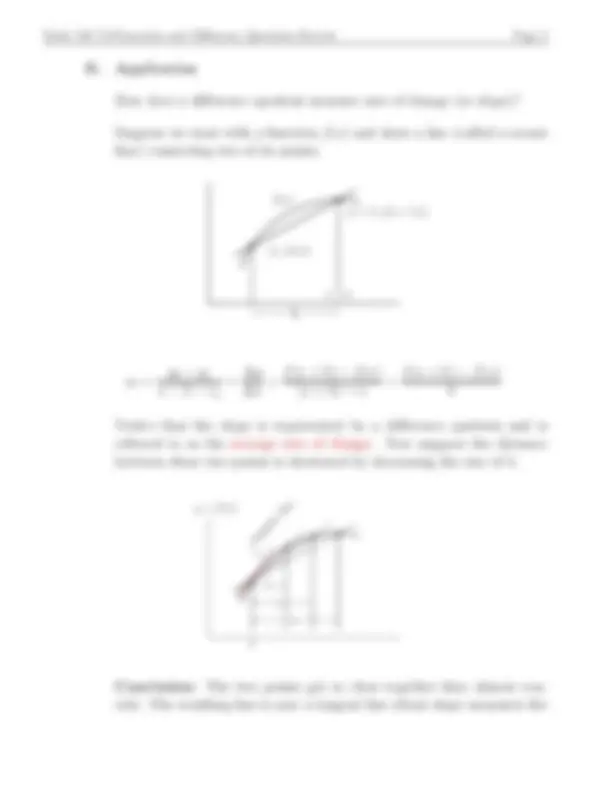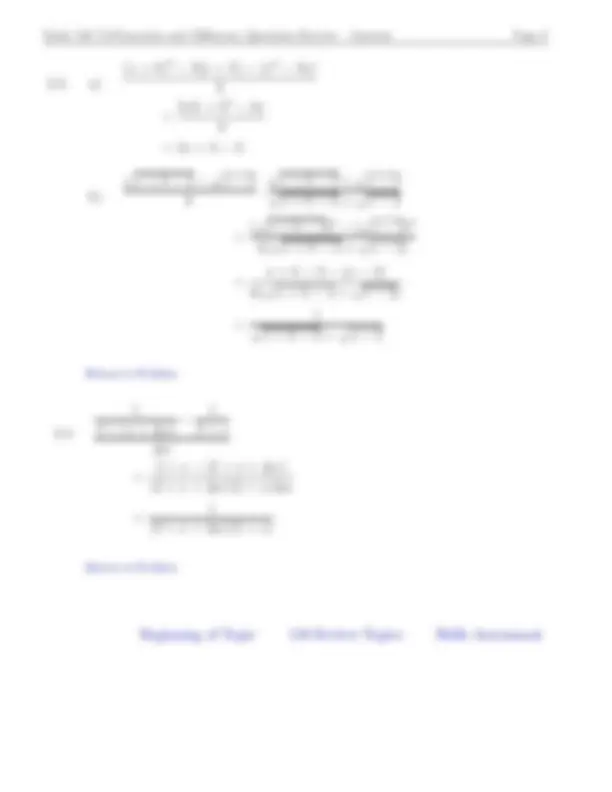






Study with the several resources on Docsity

Earn points by helping other students or get them with a premium plan


Prepare for your exams
Study with the several resources on Docsity

Earn points to download
Earn points by helping other students or get them with a premium plan
Community
Ask the community for help and clear up your study doubts
Discover the best universities in your country according to Docsity users
Free resources
Download our free guides on studying techniques, anxiety management strategies, and thesis advice from Docsity tutors
An in-depth review of composite functions and difference quotients in mathematics. It explains the concept of composite functions using the analogy of opening boxes, and provides examples of how to form composites of functions. The document also discusses the significance of composite functions and their relationship to the chain rule. Additionally, it covers difference quotients, their relationship to the slope of a line, and how they measure the instantaneous rate of change.
Typology: Study notes
1 / 8

This page cannot be seen from the preview
Don't miss anything!





I. Composition of Functions
II. Difference Quotients
Practice Problems
I. Composition of Functions
HAPPY BIRTHDAY... OK so in all likelihood today isn’t your birthday. Let’s assume it is and you’ve been given a present wrapped in a large box. You open the box and surprise!!!, inside is another box. Undaunted you open it and discover yet another box. This may appear to be a lesson in ac- cepting disappointment. Unbeknownst to you, though, you are experiencing composite function behavior.
HUH?!?! Let us explain.
The composite function is like having one function contained inside another. When you see
2 x − 1, you probably think of it as just another function, but it’s something more. It’s a composite (one function inside another). Here’s why.
Suppose f (x) =
x and g(x) = 2x−1 (think of f ( ) =
( ) as the larger box). Now place 2x − 1 inside. Mathematically this is written as f (g(x)) and we call it “f composite g”. To form a composite, try the following: f (g(x)) = f ( ) =
Now fill in the blanks with the g(x) representation and you get f (g(x)) = f (2x − 1) =
2 x − 1.
NOTE: just like f (3) means to input 3 into f , f (g(x)) means to input g into f.
Unlike boxes, any function can be placed inside another. From above, g(x) = 2x − 1. This really means g( ) = 2( ) − 1. If f (x) =
x, we have g(f (x)) = g(
x) = 2(
x) − 1 = 2
x − 1.
Alternative notation for composite functions: g(f (x)) = g ◦ f, f (g(x)) = f ◦ g.
Example: Let g(x) = x^2 + 1. Evaluate and simplify the difference
quotient
g(x) − g(2) x − 2 , x 6 = 2.
Solution: Using g(x) = x^2 + 1 and g(2) = 5,
g(x) − g(2) x − 2
(x^2 + 1) − 5 x − 2
x^2 − 4 x − 2 = x + 2.
Example: Let g(x) =
x − 2
. Evaluate and simplify the difference
quotient g(x + ∆x) − g(x) ∆x
, ∆x 6 = 0 [∆x represents the “change” in x.]
Remember: g( ) =
g(x + ∆x) − g(x) ∆x
(x + ∆x) − 2
x − 2 ∆x = (x − 2) − (x + ∆x − 2) (x + ∆x − 2)(x − 2)
∆x
=
−∆x (x + ∆x − 2)(x − 2)(∆x)
=
(x + ∆x − 2)(x − 2)
B. Application
How does a difference quotient measure rate of change (or slope)?
Suppose we start with a function f (x) and draw a line (called a secant line) connecting two of its points.
f (x)
(x, f (x))
x x^ +^ h h
m =
y 2 − y 1 x − 2 − x 1
∆y ∆x
f (x + h) − f (x) (x + h) − x
f (x + h) − f (x) h
Notice that the slope is represented by a difference quotient and is referred to as the average rate of change. Now suppose the distance between these two points is shortened by decreasing the size of h.
x
y = f (x)
tangent line•^ • ↘
h h h
Conclusion: The two points get so close together they almost con- cide. The resulting line is now a tangent line whose slope measures the
Math 150 T3-Functions and Difference Quotients Review – Answers Page 7
ANSWERS to PRACTICE PROBLEMS (Topic 3 – Functions and Difference Quotients)
3.1 a) i)
x
x
x^2
x
ii)
x^2 − 2 x
iii) (x^2 − 2 x)^2 − 2(x^2 − 2 x) = (x^2 − 2 x)(x^2 − 2 x − 2)
b) i) sin
x
ii)
sin x
c) inner: h(x) = 3x middle: g(x) = sin x outer: f (x) =
x CHECK: f (g(h))(x) = f (g(3x)) = f (sin 3x) =
sin 3x
h
g
f
Return to Problem
3.2 a) m = 3 b) m is undefined c) m = f (x + h) − f (x) h
Return to Problem
Math 150 T3-Functions and Difference Quotients Review – Answers Page 8
3.3 a)
(x + h)^2 − 3(x + h) − (x^2 − 3 x) h
=
2 xh + h^2 − 3 x h = 2x + h − 3
b)
x + h − 2 −
x − 2 h
x + h − 2 +
x − 2 √ x + h − 2 +
x − 2
=
x + h − 2)^2 − (
x − 2)^2 h(
x + h − 2 +
x − 2)
=
x + h − 2 − (x − 2) h(
x + h − 2 +
x − 2)
=
x + h − 2 +
x − 2
Return to Problem
2 + (x + ∆x)
2 + x ∆x
=
2 + x − (2 + x + ∆x) (2 + x + ∆x)(2 + x)∆x
=
(2 + x + ∆x)(2 + x)
Return to Problem
Beginning of Topic 150 Review Topics Skills Assessment